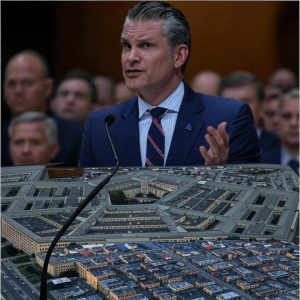A Sudden Shutdown in the Halls of Power
At precisely 9:05 a.m. on October 13, 2025, the Pentagon’s sprawling corridors transformed from a journalist’s playground into a tightly controlled enclave, as incoming Defense Secretary Pete Hegseth unveiled sweeping restrictions on media access. Reporters, accustomed to wandering freely through unclassified areas to chase leads on national security, were met with a wall of security personnel demanding badges and escorts. “No more open season on secrets,” Hegseth declared in a terse briefing, framing the policy as a bulwark against leaks that have plagued the Department of Defense for years. This abrupt pivot, effective immediately, mandates not only identification and chaperoned movement but also signed pledges prohibiting the solicitation of classified or sensitive information—measures aimed squarely at curbing what Hegseth calls “fake news” infiltration. The shockwave hit like a classified memo gone viral, leaving journalists mid-stride and igniting a national conversation on the balance between security and scrutiny.

Hegseth’s Hawkish Blueprint
Pete Hegseth’s ascent to the Pentagon’s helm was never destined to be a velvet revolution. A 45-year-old Fox News veteran and Army National Guard officer with deployments in Iraq and Afghanistan, Hegseth brings a warrior’s vigilance to a bureaucracy he has long lambasted as leaky and ideologically adrift. Nominated by President Trump in late 2024 and confirmed amid partisan fireworks, Hegseth’s early tenure echoes his book The War on Warriors, which decries “woke” influences eroding military discipline. This media lockdown, rolled out just weeks after his swearing-in, builds on interim directives from September 2025 that already flagged large swaths of the building as off-limits without escorts. Insiders say the rules stem from high-profile leaks during the Biden era, including mishandled documents on Ukraine aid and hypersonic weapons programs, which Hegseth attributes to lax oversight and adversarial reporting. “We’re not building walls to hide; we’re fortifying them to protect,” he insisted, invoking the Pentagon’s role as America’s shield in an era of cyber threats and disinformation wars.
The Mechanics of Containment
Under the new regime, journalists must now navigate a labyrinth of protocols that feel more akin to a SCIF—sensitive compartmented information facility—than a public-facing agency. Entry requires pre-approved badges tied to specific assignments, with mandatory escorts from cleared personnel for any traversal beyond the lobby. Interviews with staff demand advance scheduling, and off-the-cuff solicitations for “sensitive” details could trigger revocations or investigations. The policy explicitly targets “fake news” by empowering DoD spokespeople to flag and dispute on-the-record quotes in real-time. While unclassified tours persist, the free-roaming era—where reporters could linger in cafeterias or press rooms to glean offhand insights—has ended. Critics point to a chilling clause: reporters signing the pledge waive certain appeals if access is denied, a nod to efficiency that some see as a gag order in disguise. Proponents argue it’s long overdue, citing a 2024 Government Accountability Office report that tallied over 200 unauthorized disclosures since 2020.
Media’s Outraged Counteroffensive
The press corps, from The New York Times to independent podcasters, erupted in condemnation, branding the rules a “Soviet-style siege” on the Fourth Estate. The Reporters Committee for Freedom of the Press issued a scathing statement, warning that escorts create an “echo chamber of approved narratives,” potentially shielding misconduct like the 2021 Afghanistan withdrawal debacle. Late-night hosts piled on: Stephen Colbert mocked Hegseth as “the general who conquered the coat check,” while conservative outlets like Newsmax cheered it as a “leak-proof Pentagon” essential for Trump’s “America First” agenda. Social media amplified the divide, with #PentagonLockdown trending alongside memes of caged reporters and defiant badges. Empathy surged for veteran correspondents, many in their 60s, who view the changes as a personal affront after decades of earned trust. Yet, a vocal minority of military analysts applaud the move, arguing that unchecked access has fueled adversarial coverage from outlets like Al Jazeera, eroding troop morale.
Echoes of Erosion and Empowerment
This clampdown reverberates beyond Arlington’s five-sided fortress, probing the fragile fault lines of democratic oversight in a hyper-connected age. Historians draw parallels to Nixon’s Watergate-era media skirmishes or Obama’s drone strike opacity, but Hegseth’s version feels amplified by AI deepfakes and TikTok-fueled misinformation. Supporters, including veterans’ groups, empathize with the intent: leaks don’t just embarrass; they endanger lives, as seen in the 2023 Discord gaming chat fiasco that exposed submarine tech. Detractors counter that sunlight is the best disinfectant, fearing a precedent where “sensitive” becomes synonymous with “inconvenient.” As polygraph tests for insiders loom—another Hegseth brainchild to preempt breaches—the policy could reshape how America wages informational wars, prioritizing control over candor.
The Battle Lines Drawn
With lawsuits brewing from media coalitions and congressional hearings slated for November, Hegseth’s gambit hangs in precarious balance. Will it stem the tide of scandals, or sow seeds of deeper distrust? In a nation where truth is the ultimate national security asset, the Pentagon’s new gates test whether fortification fosters strength or fosters shadows. As one anonymous DoD staffer whispered to a escorted embed: “We’re safer now—or just more silent?” The verdict unfolds, one badge at a time.
Leave a Reply